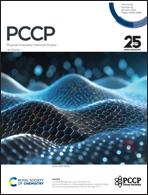Refining DIIS algorithms for Si and GaAs solar cells: incorporation of weight regularization, conjugate gradient, and reverse automatic differentiation techniques†
Abstract
Pivotal enhancements in electronic minimization algorithms, which are vital for the advancement of computational materials science, are introduced in this research. Our research is dedicated to refining the DIIS algorithm specifically for electronic structure calculations of silicon (Si) and gallium arsenide (GaAs) solar cells, aiming to enhance their efficiency and stability. We have enriched DIIS by integrating a weight regularization factor, significantly bolstering its convergence stability. This modification enhances iteration robustness and curtails the average iteration duration, thus streamlining the convergence process. Furthermore, we have incorporated the conjugate gradient (CG) algorithm to proficiently resolve symmetric positive definite residual matrices. This inclusion substantially accelerates the solution-finding process within the DIIS framework. A novel aspect of our research is the application of reverse automatic differentiation (AD), deployed in two distinct methodologies: the construction of the Jacobian matrix and direct chain rule application for gradient computation. These approaches involve sophisticated mathematical techniques that enhance computational precision and efficiency specifically for Si and GaAs solar cell materials in determining the optimal weights for residual combinations during DIIS iterations. The integration of these advanced methods into the DIIS algorithm not only augments its convergence stability but also ensures a substantial reduction in total computational time. Our findings demonstrate that the enhanced DIIS, CG-enhanced DIIS, and AD-integrated DIIS methods collectively lead to a more efficient electronic minimization process. This balance of stability and efficiency is crucial in high-performance computational materials science, particularly for complex systems analysis. The findings of this research represent a notable advancement in computational strategies for Si and GaAs solar cell materials, providing enhanced methodologies and insights that significantly improve the efficiency and stability of electronic structure calculations in these critical components of renewable energy technologies.



 Please wait while we load your content...
Please wait while we load your content...